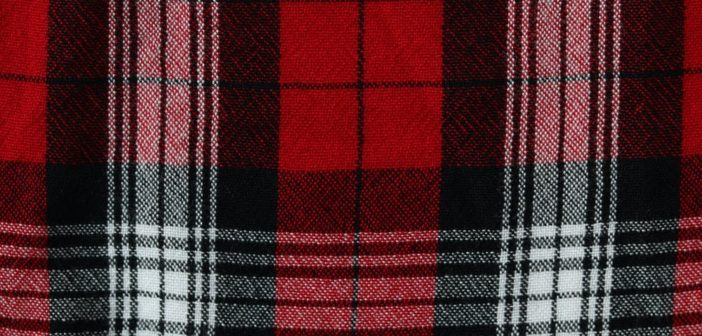by: Amber Fink, Staff Writer
Everything we wear is made out of fabric, sometimes more than one type of fabric. Often, we will notice the 100 percent cotton tag on our clothing. Sometimes there is a combination of 70 percent cotton and 30 percent polyester. All fabrics have different textures, weights and warmth they bring to our bodies. The following fabrics are the top 12 fabrics used while making clothing. Therefore, many of us have one of these pieces of fabric on our bodies daily.
Cotton voile: Voile is soft, lightweight cotton that is breathable and semi-sheer. Imported from Italy, voile is an ideal fabric for blouses and often feature unusual prints.
Cotton lawn: Lawn is very similar to cotton voile but is slightly crisper.
This fabric is nice to wear during hot summer days. It is lightweight, woven, semi-transparent, very fine, smooth, and has no texture on its surface. This fabric is most commonly produced is Laon, France which is the major producer of linen lawn.
Rayon challis: Raylon is a soft, plain woven, lightweight fabric and often printed. Although this fabric is lightweight like the cotton voile and cotton lawn, this fabric is slightly heavier than both of those. It is usually made from rayon or wool. Challis is used to create faux chenille fabrics, which are good for making scarves and baby blankets, by layering and stitching all fabric with the exception of the bottom layer.
Chambray: Chambray is another smooth, lightweight fabric. This fabric is a linen-finished gingham cloth with a white weft and a colored warp. According to the standard dictionary the relationship between the weft and the warp is “(in weaving) the crosswise threads on a loom over and under which other threads (the warp) are passed to make cloth.” This creates a mottled appearance. This fabric is most useful when making spring or summer tops or skirts.
Denim: Denim is most likely one of the most familiar names of fabrics. Instantly, when someone thinks of denim they most likely think of jeans or a denim jacket. Denim is defined as sturdy cotton with a warp-faced textile; therefore the weft passes under two or more warp threads. This fabric does not stretch as easily as most.
Double gauze: Double gauze is a unique fabric that consists of exactly what it sounds like, two layers of gauze sown together. This is not the fabric someone would want to use for clothing due to its heaviness and the lack of breathability. However, this fabric is great for quilt making. Double gauze quilts often appear cozy, with a soft wrinkled appearance.
Knit: This fabric is the second most commonly worn following denim. This fabric has a light to medium weight. This is considered someone’s “go-to” when sewing. Someone will have a difficult time going wrong with this fabric since it brings so much opportunity. This fabric can stretch in all directions, making it ideal for t-shirts, loungewear, yoga pants and so much more!
Silk: Silk is a versatile fabric because it is smooth, soft and strong. Silk is a lightweight fabric that drapes easily and can appear shimmery. Although this has a very nice texture, it’s hard not to let it slip out of your hands since it can be so slippery while trying to move the fabric through the sewing machine. For those who want a challenge while sewing, they should try sewing with silk as it is sometimes difficult to work with for handmade items. Silk is an adaptable fabric that can be used or worn during any time of the year from the lining of winter cots to lightweight summer dresses.”
Satin: Satin can vary from lightweight to heavyweight, depending on the type of satin. Like silk, it has a glossy appearance and is slippery. This fabric is great for pajama making since this fabric is very smooth. Sometimes people have satin bed sheets, but they should keep in mind they are very slippery so the sheets have a better chance of slipping off other the bed.
Linen: Linen is a medium-weight fabric that is slightly elastic, causing wrinkles to form. This fabric conducts heat adequately, making it a great fabric to use with winter clothing. This fabric is quite diverse, as it is useful for home garnets like curtains, covers, a lounge pillows.
Wool: According to Craftsy, “There are over 200 different types of wool, coming from 40 different breeds of sheep, so the weight will vary depending on the type of wool. Wool is extremely hardwearing and versatile. It is also very warm and a good choice for colder weather garments,” This fabric is produced by animals like sheep, cashmere and mohair from goats; qiviut from muskoxen, angora from rabbits and other types of wool comes from camelids. A popular brand of boots that uses wool is UGGS.
Flannel: Flannel is a soft, lightweight fabric. This is a great fabric to use on shirts, pants and jackets during the winter season. Flannel is composed of wool, cotton, or some other kind of fibers. Flannel can be created extra soften by being “brushed.” Brushing is a process when a fine metal brush rubs the fabric to raise fibers from the loosely spun yarns. A well-known example of flannel is a plaid t-shirt.
A Saint Leo University staff member, Ellen Sheridan, is a quilt maker. She uses all cotton all of the time. She has a great talent and can make quilts in any where from one day to 6 months depending on the difficulty. “A quilt for a king size bed is 20 yards,” says Sheridan. She has also made tree skirts and wall hangings with this fabric. “Cotton can be used on anything someone would have to iron, for example purses, clothes, table runners, napkins. I like that cotton is washable,” says Sheridan. Sheridan personally feels that when buying cotton, the quality of it is most important. With good quality come good color, shape, and hold. In other words, “you get what you pay for”, says Sheridan.
A great place to purchase many of these fabrics is Joann Fabrics and even online, where some purchases can be made in bulk.




